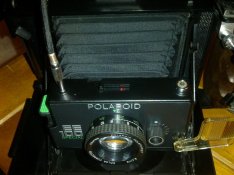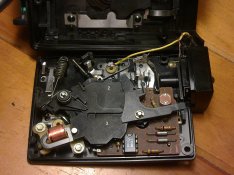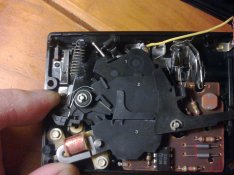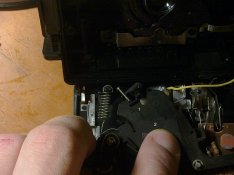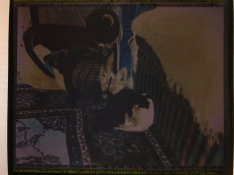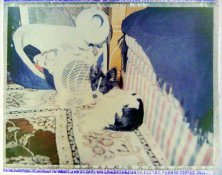Just got hold of an EE100 today. Of course, I had to pull it apart and modify it straight away!
Here's what I did:
Disassembly:
With camera closed:
Open back cover and remove batteries. Unscrew battery contacts. This should release the bellows from the front panel.
With camera open:
Unclip plastic front cover (one clip, either side).
Remove 2 screws on bottom of front shutter/lens housing.
Swivel mechanism so that you can remove the 4 screws from the back panel. The shutter/lens assembly (front case and back panel attached) can now be removed.
The back panel will come off. Be careful that the shutter spring cover does not come loose. Mine did not spring off unexpectedly, but you will need to remove this if you do the cable release mod.
Cable release mod:
I have a flash bracket with a cable release fitted but the centre pin on the release cable was not long enough to trip the shutter. It was moving it about 75% of the way.
To fix this, I glued in a small piece of plastic (approx 6mm dia x 6mm long), tapered to fit the existing shutter release (inside the camera).
PC socket mod:
My little Sunpak flash gives a good output, is not huge in size and also has a pc cable.
I recycled a pc socket from an old camera part I had for this one. Drilling a small hole (about 8mm from the left side) into the top of the case, right next to the flashcube socket (there is only a small spot to fit it in here).
Then I Connected the PC socket to the contacts inside - this is easy to figure out:
If you trip the mechanism while the front cover is off, you'll see the flash contacts closing as the shutter opens. You may need to take some 1200 grit sandpaper and clean up the contacts as they can be quite corroded.
I soldered onto one of the flashcube socket contacts and onto the (brass) terminal that the large battery contact screws into.
Sorry that I did not take pics as I was doing this, but it is a fairly straightforward operation, as long as you use some nice thin wire and route it so that it does not interfere with the other internals.
Faulty focus?
One other problem that people have also complained about when they get these cameras is that the focus is off. I'm glad I checked mine out completely as I noticed the front lens had become detached from the ring. You can pull off the range ring, then the front ring that holds the front lens element. I glued mine back in with a few (very small!) drops of epoxy. I wouldn't recommend cyano (super-glue), as it tends to react with plastic (this is a plastic lens).
OK, all this was completed about 2 hours ago and I have not yet calibrated my focus or taken any shots at all (at 1AM). I expect it to work fine with the flash (which fires when I trip the shutter). The shutter appears to be working fine with a couple of new batteries.
(If you are getting black pics, it's likely the shutter is not opening&closing. The circuit inside takes care of the exposure and needs power to function).
OK I hope that helps anybody. I couldn't find much info about using electronic flash. The flash should be firing as the shutter opens and I expect that the internal circuit should compensate for the light level (if you place your finger over the sensor in the center of the dark/light knob you can see the long shutter time easily).
Looking forward to some pics tomorrow! Also I'll try my hand at recovering the negs too. I expect the '75' setting will be just enough over-exposure to give good results).
View attachment 79397
View attachment 79398

















